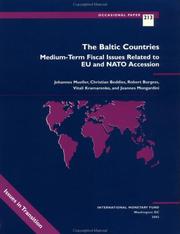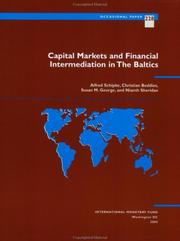| Listing 1 - 10 of 12 | << page >> |
Sort by
|
Book
ISBN: 1462397344 1451986416 1282106732 1451899416 9786613800084 Year: 1999 Publisher: Washington, D.C. : International Monetary Fund,
Abstract | Keywords | Export | Availability | Bookmark
 Loading...
Loading...Choose an application
- Reference Manager
- EndNote
- RefWorks (Direct export to RefWorks)
This paper considers the potential variables that have determined economic growth in The Gambia during 1964–98. The results indicate that The Gambia’s aggregate production function exhibits increasing returns to scale, thus supporting the endogenous growth-type model. The impact of private investment—and thus private capital accumulation—on output is large and significant. Furthermore, increases in public investment boost output substantially. Finally, the effects associated with human capital accumulation are positive and statistically significant. The paper also estimates a series on total factor productivity growth that indicates that The Gambia was able to use its resources more efficiently.
Investments: General --- Investments: Stocks --- Labor --- Production and Operations Management --- Macroeconomic Analyses of Economic Development --- Economic Growth and Aggregate Productivity: General --- Economywide Country Studies: Africa --- Time-Series Models --- Dynamic Quantile Regressions --- Dynamic Treatment Effect Models --- Diffusion Processes --- Investment --- Capital --- Intangible Capital --- Capacity --- Human Capital --- Skills --- Occupational Choice --- Labor Productivity --- Pension Funds --- Non-bank Financial Institutions --- Financial Instruments --- Institutional Investors --- Production --- Cost --- Capital and Total Factor Productivity --- Macroeconomics --- Labour --- income economics --- Investment & securities --- Private investment --- Capital accumulation --- Human capital --- Stocks --- Total factor productivity --- National accounts --- Financial institutions --- Saving and investment --- Industrial productivity --- Gambia, The
Book
ISBN: 1462358144 1452794693 1281605751 1451892128 9786613786449 Year: 1999 Publisher: Washington, D.C. : International Monetary Fund,
Abstract | Keywords | Export | Availability | Bookmark
 Loading...
Loading...Choose an application
- Reference Manager
- EndNote
- RefWorks (Direct export to RefWorks)
This paper considers the interaction between the private sector, the monetary authority, and the fiscal authority, and concludes that unrestricted central bank independence may not be an optimal way to collect seigniorage revenues or stabilize supply shocks. Moreover, the paper shows that the implementation of an optimal inflation target results in optimal shares of government finances—seigniorage, taxes, and the spending shortfall—from society’s point of view but still involves suboptimal stabilization. Even if price stability is the sole central bank objective, a positive inflation target has important implications for the government’s finances, as well as for stabilization.
Banks and Banking --- Inflation --- Money and Monetary Policy --- Public Finance --- Economic Theory --- Monetary Policy --- Fiscal Policy --- Price Level --- Deflation --- National Government Expenditures and Related Policies: General --- Banks --- Depository Institutions --- Micro Finance Institutions --- Mortgages --- Agriculture: Aggregate Supply and Demand Analysis --- Prices --- Central Banks and Their Policies --- Monetary economics --- Macroeconomics --- Public finance & taxation --- Banking --- Economic theory & philosophy --- Inflation targeting --- Expenditure --- Supply shocks --- Monetary policy --- Economic theory --- Central bank autonomy --- Central banks --- Expenditures, Public --- Banks and banking --- Supply and demand --- United Kingdom
Book
ISBN: 146233072X 1452730032 1282109383 1451901275 9786613802279 Year: 2000 Publisher: Washington, D.C. : International Monetary Fund,
Abstract | Keywords | Export | Availability | Bookmark
 Loading...
Loading...Choose an application
- Reference Manager
- EndNote
- RefWorks (Direct export to RefWorks)
In the past decades, much work has been geared toward solving the problem of time inconsistency in monetary policy and analyzing the coordination problem between fiscal and monetary policy. This paper provides a review of the theoretical background to these theories, while also focusing on their inherent problems. It concludes that while the literature makes a strong case for central bank independence, more work should be done in the area of determining the desirable degree of independence with a view to the interplay between fiscal and monetary policy.
Banks and Banking --- Inflation --- Money and Monetary Policy --- Public Finance --- Price Level --- Deflation --- Monetary Policy --- Banks --- Depository Institutions --- Micro Finance Institutions --- Mortgages --- Fiscal Policy --- Debt --- Debt Management --- Sovereign Debt --- National Government Expenditures and Related Policies: General --- Macroeconomics --- Monetary economics --- Banking --- Public finance & taxation --- Inflation targeting --- Fiscal policy --- Public debt --- Prices --- Monetary policy --- Expenditure --- Banks and banking --- Debts, Public --- Expenditures, Public --- New Zealand
Article
Abstract | Keywords | Export | Availability | Bookmark
 Loading...
Loading...Choose an application
- Reference Manager
- EndNote
- RefWorks (Direct export to RefWorks)

ISBN: 1589061047 9781589061040 Year: 2002 Volume: 213 Publisher: Washington (D.C.) IMF
Abstract | Keywords | Export | Availability | Bookmark
 Loading...
Loading...Choose an application
- Reference Manager
- EndNote
- RefWorks (Direct export to RefWorks)
International finance
---
NATO
---
European Union
---
Baltic Area
---
Fiscal policy
---
North Atlantic Treaty Organization
---
Economische landenstudies: Baltische Staten.
---
Fiscaal beleid: Baltische Staten.
---
33 economie
---
(474.2) Estland
---
(474.3) Letland
---
(474.5) Litouwen
---
(4-67EU) EU
---
336.2 <474>
---
339.92

ISBN: 1589062728 9781589062726 Year: 2004 Volume: 228 Publisher: Washington (D.C.) IMF
Abstract | Keywords | Export | Availability | Bookmark
 Loading...
Loading...Choose an application
- Reference Manager
- EndNote
- RefWorks (Direct export to RefWorks)
Money market. Capital market --- Baltic Area --- Capital market --- Intermediation (Finance) --- Banks and banking, Foreign --- European Union --- Membership --- Baltic States --- Economic conditions --- Membership. --- Economic conditions. --- -Intermediation (Finance) --- -Banks and banking, Foreign --- -336.76 --- marche des capitaux --- intermediaires financiers --- europe de l'est --- EE / Estonia - Estland - Estonie --- LT / Lithuania - Litouwen - Lituanie --- LV / Latvia - Letland - Lettonie --- 333.602 --- 333.101 --- 333.50 --- 330.05 --- 332.041 --- 336.76 Beurswezen. Geldmarkt. Valutamarkt. Binnenlandse geldmarkt. Valutamarkt --- Beurswezen. Geldmarkt. Valutamarkt. Binnenlandse geldmarkt. Valutamarkt --- Foreign banks and banking --- Offshore banking (Finance) --- Financial intermediation --- Capital markets --- Market, Capital --- kapitaalmarkt --- financiele tussenpersonen --- oost europa --- Activiteiten en evolutie van de financiële markten. --- Banksysteem en bankstelsel. --- Financiële instellingen: algemeenheden. --- Working papers --- 336.76 --- Finance --- Financial institutions --- Loans --- Money market --- Securities --- Crowding out (Economics) --- Efficient market theory --- Banksysteem en bankstelsel --- Financiële instellingen: algemeenheden --- Activiteiten en evolutie van de financiële markten --- E.U. --- Capital market - Baltic states --- Intermediation (Finance) - Baltic states --- Banks and banking, Foreign - Baltic states --- Baltic States - Economic conditions
Book
ISBN: 9781589067929 1589067924 Year: 2008 Volume: 266 Publisher: Washington International Monetary Fund
Abstract | Keywords | Export | Availability | Bookmark
 Loading...
Loading...Choose an application
- Reference Manager
- EndNote
- RefWorks (Direct export to RefWorks)
Low-income countries continue to face significant challenges in meeting their vast development needs while maintaining a sustainable debt position, even after many of these countries have benefited from substantial debt relief. These challenges are further exacerbated by changes in the financial landscape, including the emergence of new creditors and investors, the use of more complex financing vehicles, and the development of domestic markets. The joint World Bank/IMF debt sustainability framework is well placed to help address these challenges and reduce the risks of renewed episodes of debt distress. This paper explains the analytical underpinnings of the framework and the means to ensure its full effectiveness.--Publisher's description.
Debts, External --- Economic development --- Developing countries --- Economic policy --- Developing Countries --- developpement economique --- economisch beleid --- pays en voie de developpement --- -Economic development --- -330.05 --- 336.3435 --- Development, Economic --- Economic growth --- Growth, Economic --- Economics --- Statics and dynamics (Social sciences) --- Development economics --- Resource curse --- Debts, Foreign --- Debts, International --- External debts --- Foreign debts --- International debts --- Debt --- International finance --- Investments, Foreign --- Economic policy. --- economische ontwikkeling --- politique economique --- ontwikkelingslanden --- 330.05 --- Debts, External - Developing countries --- Economic development - Developing countries --- Developing countries - Economic policy
Book
ISBN: 1462391559 1452728135 Year: 2009 Publisher: Washington, D.C. : International Monetary Fund,
Abstract | Keywords | Export | Availability | Bookmark
 Loading...
Loading...Choose an application
- Reference Manager
- EndNote
- RefWorks (Direct export to RefWorks)
Les pays à faible revenu continuent d'éprouver des difficultés considérables à satisfaire leurs importants besoins en développement tout en préservant la viabilité de leur dette, même après avoir bénéficié d'un important allégement de la dette pour nombre d'entre eux. Ces difficultés sont encore exacerbées par l'évolution du paysage financier, dont l'émergence de nouveaux créanciers et investisseurs, le recours à des instruments de financement complexes, et le développement des marchés intérieurs. Le cadre de viabilité de la dette, élaboré conjointement par la Banque mondiale et le FMI, est très utile pour aider à résoudre ces difficultés ainsi qu'à réduire les risques de réapparition d'épisodes de surendettement. Ce document présente les fondements théoriques du cadre et explique comment en tirer tout le parti.
Exports and Imports --- Financial Risk Management --- Public Finance --- International Lending and Debt Problems --- Debt --- Debt Management --- Sovereign Debt --- Trade Policy --- International Trade Organizations --- International economics --- Public finance & taxation --- Finance --- Debt sustainability analysis --- Debt sustainability --- External debt --- Public debt --- Debt service --- Debts, External --- Debts, Public --- Export credit --- United States
Book
Year: 2008 Publisher: Washington, D.C. IMF
Abstract | Keywords | Export | Availability | Bookmark
 Loading...
Loading...Choose an application
- Reference Manager
- EndNote
- RefWorks (Direct export to RefWorks)
Book

ISBN: 1455298328 1452740259 Year: 2005 Publisher: Washington, D.C. : International Monetary Fund,
Abstract | Keywords | Export | Availability | Bookmark
 Loading...
Loading...Choose an application
- Reference Manager
- EndNote
- RefWorks (Direct export to RefWorks)
Since 2000, Armenia's economic performance has been remarkable. Real economic growth has averaged 11 percent a year, annual inflation has averaged 3 percent, and poverty and inequality have fallen. The country has outperformed other low-income countries including other members of the Commonwealth of Independent States. This is particularly impressive given the geographical location of Armenia, the closure of two critical borders, and occasional political turmoil. The key factors behind Armenia's economic performance are prudent monetary and fiscal policies, liberal trade and foreign exchange regimes, rapid and relaively well-sequenced structural reforms, and support from the Armenian diaspora. In addition, the implementation of a poverty reduction strategy since 2002 has complemented the effect of economic growth on reducing poverty. This book assesses the country's economic transformation during the last 10 years and discusses the challenges to sustaining these successes.
Armenia (Republic) --- Economic conditions --- Economic policy --- Banks and Banking --- Exports and Imports --- Macroeconomics --- Public Finance --- Poverty and Homelessness --- Taxation --- Taxation, Subsidies, and Revenue: General --- Banks --- Depository Institutions --- Micro Finance Institutions --- Mortgages --- Aggregate Factor Income Distribution --- Trade: General --- National Government Expenditures and Related Policies: General --- Public finance & taxation --- International economics --- Banking --- Poverty & precarity --- Finance --- Revenue administration --- Expenditure --- Poverty --- Commercial banks --- Financial institutions --- Securities markets --- Financial markets --- Banks and banking --- Revenue --- Expenditures, Public --- Income distribution --- Armenia, Republic of
| Listing 1 - 10 of 12 | << page >> |
Sort by
|

 Search
Search Feedback
Feedback About
About Help
Help News
News